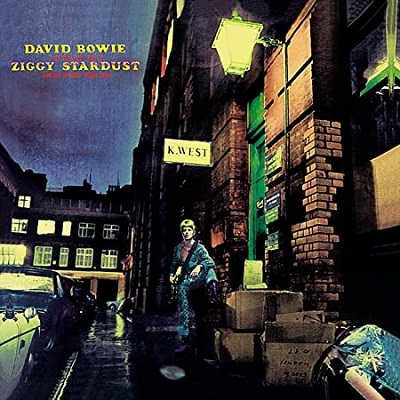Loosely based on the characterizations of “A Clockwork Orange” — but of a much more provocative nature — The Rise And Fall Of Ziggy Stardust And The Spiders From Mars more or less introduced the world to David Bowie. Prior to the album’s release in 1972, Bowie had struggled to maintain his momentum — both financially and artistically. Initially on the singer-songwriter circuit, he gained a little ground with “Space Oddity,” which became a hit single in the UK. Once he teamed up with guitarist Mick Ronson and producer Tony Visconti, the effervescent chameleon became more adventurous and sensationalistic on the edgy The Man Who Sold The World. He backed away from the hard-driven formula on Hunky Dory, but made a remarkable step forward as a songwriter and performer. From there, he mutated into what was soon to become the ultimate rock and roll alien: Ziggy Stardust.
Bowie called him a “plastic rock star,” but Ziggy Stardust was more of a composite, drawing off such contemporaries as Marc Bolan and Iggy Pop, as well as Vince Taylor, the original “Black Leather Rebel” who had made an impression on the young David Jones back in the 60s. From 1972 and into 1973, Ziggy Stardust and David Bowie became one and the same. Once he made a declaration about his sexual preferences to the press and backed it up with calculated style and presentation, everything quickly fell into place. It would have been one thing if the whole androgynous, flamboyant angle was nothing more than show biz schmaltz — and to a large extent it was — but Bowie and the Spiders came through with a solid collection of tunes. Ronson functioned as the singer’s right hand man, with a lethal right hand of his own that flew and withdrew over the steady pace laid down by bassist Trevor Bolder and drummer Woody Woodmansey. With Bowie leading the charge, The Rise And Fall Of Ziggy Stardust And The Spiders From Mars is an intoxicating, gender-bending thrill ride from start to finish.
Although the concept behind the album is shaky at best, each song offers a glimpse into Bowie’s mindset. “Five Years” prognosticates the end of the world with a Dylanesque build and bite. From there, the plot seamlessly unravels without reason or apology. In fact, “Moonage Daydream” and “Hang On To Yourself” were recorded earlier and released as singles under the pseudonym of Arnold Corns. Somehow, they both figured into the ambiguity of the story and were re-recorded for the album. On the other hand, “Starman” was a last minute entry subsequently released as Ziggy’s first single. It made the UK’s Top Ten, while languishing in the upper trenches of America’s Hot 100. Naturally, “Ziggy Stardust” shed some light on the plotline (if there ever was one), although there is speculation that it’s actually about Jimi Hendrix (“he played it left hand, but made it too far”). “Suffragette City” successfully brings down the house with its infamous “wham bam thank you ma’am!” while “Rock N’ Roll Suicide” ends the whole affair on an introspective note. Produced by Ken Scott, The Rise And Fall Of Ziggy Stardust And The Spiders From Mars has been reissued in various configurations and formats over the years. In 2017, it was selected for preservation in the National Recording Registry, called “culturally, historically, or artistically significant” by the Library of Congress. Like so many things, the legend of Ziggy Stardust eventually fell to earth, yet the legacy of David Bowie will never fall out of fashion.
~ Shawn Perry




















